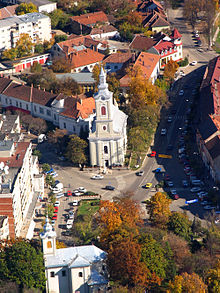Beiuș
|
Beiuș Belényes |
||||
|
||||
| Basic data | ||||
|---|---|---|---|---|
| State : |
|
|||
| Historical region : | Screeching area | |||
| Circle : | Bihor | |||
| Coordinates : | 46 ° 40 ′ N , 22 ° 21 ′ E | |||
| Time zone : | EET ( UTC +2) | |||
| Height : | 191 m | |||
| Area : | 24.46 km² | |||
| Residents : | 10,667 (October 20, 2011) | |||
| Population density : | 436 inhabitants per km² | |||
| Postal code : | 415200 | |||
| Telephone code : | (+40) 02 59 | |||
| License plate : | bra | |||
| Structure and administration (as of 2016) | ||||
| Community type : | Municipality | |||
| Structure : | 1 District / cadastral municipality: Delani | |||
| Mayor : | Petru Mlendea-Căluș ( PNL ) | |||
| Postal address : | P-ța Samuil Vulcan, no. 14 loc. Beiuș, jud. Bihor, RO-415200 |
|||
| Website : | ||||
Beiuș ( Hungarian Belényes ) is a city in Bihor County in the Kreischgebiet in Romania .
Geographical location
Beiuș is located on an area of 24.46 km² in the valley of the same name in the eastern foothills of the Apuseni Mountains . On the Crișul Negru ( Black Screech ) - a source river of the Kreisch - and on the European route 79 , the small town of Beiuș is located 62 kilometers southeast of the district capital Oradea ( Greater Oradea ).
history
Beiuș was first mentioned in 1263 - after the Mongol storm of 1241. The city was later a regional cultural center of Hungary in the Austro-Hungarian monarchy .
According to reports by M. Roska and D. Popescu , archaeological finds from the Copper Age were made in the area of the small town .
Town twinning
The small town of Beiuș has had partnerships with the Hungarian towns of Komló since 1992, with Békéscsaba since 1999 and with Méhkerék since 2011.
Attractions
- The Roman Catholic Church Sf. Treime , built in 1752, is a listed building.
- The Romanian uniate church of St. Demetrius, built 1780–1782 and consecrated in 1800 by Bishop Ignatius Darabanth, is a listed building.
- The Forgach House , built in 1753, is today the administrative seat of the Roman Catholic parish and is a listed building.
- The Samuil Vulcan College, built in 1828 and renovated in 1895, is a listed building.
- The house of Ioan Ciordaș , built in the 19th century, is now the city museum and is a listed building.
- In the vicinity of Beiuş there is the stalactite cave Peştera Urşilor ( Bear Cave ), which was discovered and developed in the 1970s. Today it is a very worthwhile destination for tourists.
Web links
Individual evidence
- ↑ 2011 census in Romania ( MS Excel ; 1.3 MB)
- ^ Institute Of Archeology - Beiuș, accessed July 8, 2012 (Romanian)
- ↑ a b c d e List of historical monuments of the Romanian Ministry of Culture, updated 2010 (PDF; 7.1 MB)






